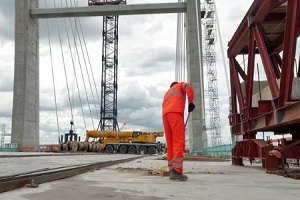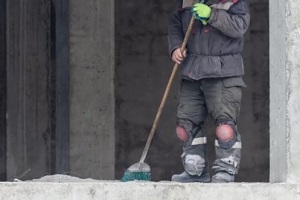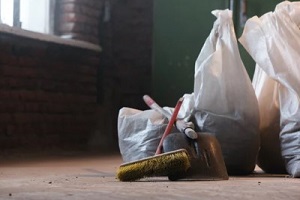 Keeping construction sites clean is of vital importance when it comes to ensuring the safety of everyone on site. From removing tripping hazards to eliminating toxic dust, there are numerous cleaning-related tasks that must be performed regularly to keep everyone safe.
Keeping construction sites clean is of vital importance when it comes to ensuring the safety of everyone on site. From removing tripping hazards to eliminating toxic dust, there are numerous cleaning-related tasks that must be performed regularly to keep everyone safe.
However, like all of the other tasks carried out on construction sites, cleaning must be performed carefully to avoid hazards, and sweeping is no exception. Here are 11 helpful safety tips for construction site sweeping.
Avoid Dry Sweeping
Dry sweeping should be avoided whenever possible because it has a tendency to create high levels of dust that can make their way into your eyes and lungs and compromise your health. Use a damp cloth or water spray to help remove dust and debris and keep it from becoming airborne while sweeping.
Always Sweep in a Well-ventilated Area
Any time you are sweeping a construction site, it is important to ensure the area is well ventilated. If you must sweep an enclosed space that cannot be ventilated adequately, work quickly or break the work down into smaller chunks of time to avoid prolonged exposure. In some cases, it may be possible to use mechanical ventilation to improve the air quality in the space you need to sweep.
Start With a Broom Sweeper Before Using an Industrial Sweeper
When using an industrial sweeper, it is best to begin with a mid-sized broom. In general, brooms tend to pick up heavier material better, while vacuums are more suited to picking up lighter material. That is why the first pass should ideally be performed using a broom sweeper, and this can be followed up with a vacuum sweeper as needed.
Keep Industrial Sweepers Well Maintained
If you use large industrial sweepers, it is important to keep in mind that they contain multiple moving parts and are regularly operated in tough conditions, which means they are subject to significant wear and tear. It is best to track for maintenance by the hour, particularly with hydraulic machines.
Train Industrial Sweeper Drivers to Maintain Eye Contact
 Eye contact is vital for those operating industrial sweepers at all times so they are aware of other equipment that may be moving around in their path. A good rule of thumb is to stop sweeping if you can no longer see the eyes of the individuals operating other equipment in the area.
Eye contact is vital for those operating industrial sweepers at all times so they are aware of other equipment that may be moving around in their path. A good rule of thumb is to stop sweeping if you can no longer see the eyes of the individuals operating other equipment in the area.
Sweepers should never assume the other machine operator will get out of their way. On a construction site, everyone is focused on their job and may not be as aware of their surroundings as one would expect. Because many operators wear hard hats and sunglasses, hand signals may be needed for proper communication on the site.
Be Sure to Use Appropriate Tools
Construction site sweeping should always be carried out using proper tools. This means using brushes and extraction units in conjunction with wheelbarrows and other items that are designed specifically for construction site sweeping for smaller jobs and appropriate industrial sweeping machinery for bigger sweeping jobs.
Make sure that all the equipment and tools used for the work are in good condition and proper working order before beginning, and stop immediately if they do not function as expected. Be sure to follow all of the safety precautions and instructions provided by the equipment’s manufacturer, taking care not to modify these items or use them for a purpose other than what they are intended for at any time.
Properly Store Equipment and Tools
Be sure to store construction sites sweeping equipment and tools properly when you no longer need them. Do not leave any tools or equipment lying around a construction site as they could block access paths or pose a tripping hazard. It is also important to unplug power tools when you are not using them and place them in a safe location where they will not be exposed to water or moisture.
Wear Appropriate Personal Protective Equipment While Sweeping
Sweeping a construction site is a serious job full of potential hazards, so it is important to wear personal protective equipment for every step of the process. This typically includes goggles, high-visibility clothing, boots and gloves. Before beginning, make sure that all personal protective equipment is clean and fits properly.
If the dust being swept could contain wood or silica, the sweeper should wear Respiratory Protective Equipment (RPE) that has an Assigned Protection Factor (APF) of at least 20. It is equally important to ensure that the equipment fits properly or it may not provide the expected degree of protection.
Sweep at Regular Intervals Rather Than Waiting Until the End of the Project
 Dust and debris have a tendency to accumulate quickly, so it is important to sweep your construction site on a frequent basis to prevent buildup and keep the job at a manageable level.
Dust and debris have a tendency to accumulate quickly, so it is important to sweep your construction site on a frequent basis to prevent buildup and keep the job at a manageable level.
Waiting until the end of the project or even the end of each day may mean that the task is too big to approach safely.
Dispose of Debris and Dust Properly
When sweeping in a construction site, it is imperative to dispose of debris and dust properly. These materials should be placed in sealed bags or containers with clear labels identifying the source of the dust or debris. Avoid mixing dust and debris with other types of waste material on the construction site.
Report Injuries and Other Incidents Immediately
Any injuries, hazards or other incidents related to construction site sweeping should be reported to a supervisor or site manager immediately, even if they do not seem significant. If you experience any symptoms of dust exposure, such as shortness of breath, wheezing or coughing, be sure to seek medical attention right away.
Reach Out to the Northern Virginia Site Work Professionals
Dirt Connections offers a range of heavy construction services, and our team of experienced contractors is prepared to handle everything from site preparation to hauling and full cleanup in Northern Virginia. Contact us today to find out how we can help make your next construction project a success.
Summary

Dirt Connections was started with one goal in mind: providing quality residential and commercial construction services to clients on time and on budget. Reach out for more information on how we can support your next project.
For your convenience our estimates are free and by appointment. Call 703-940-9949 for a free estimate today!










































